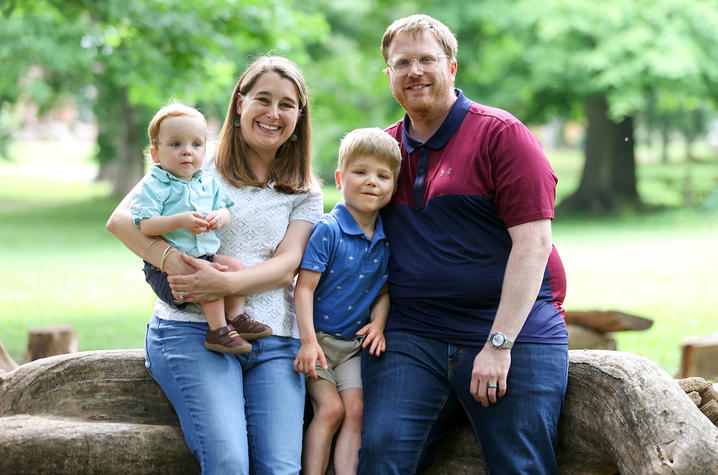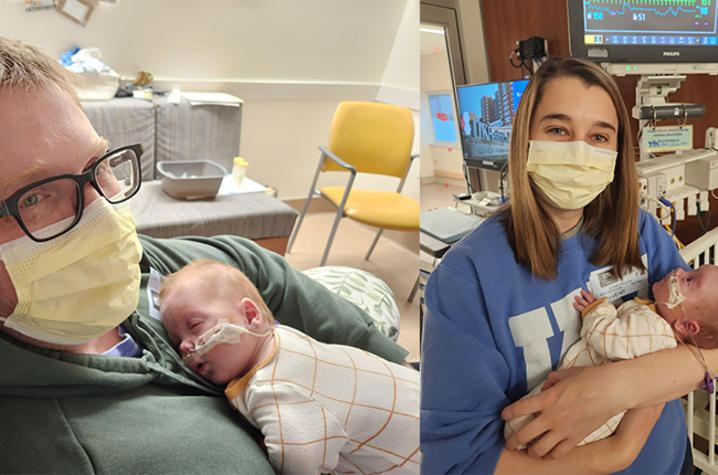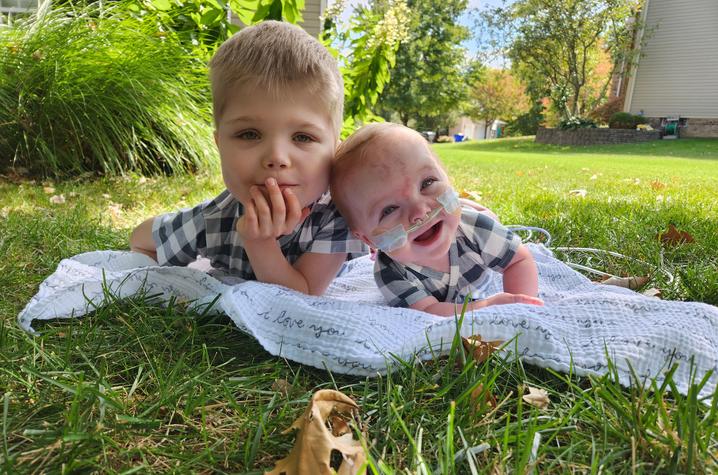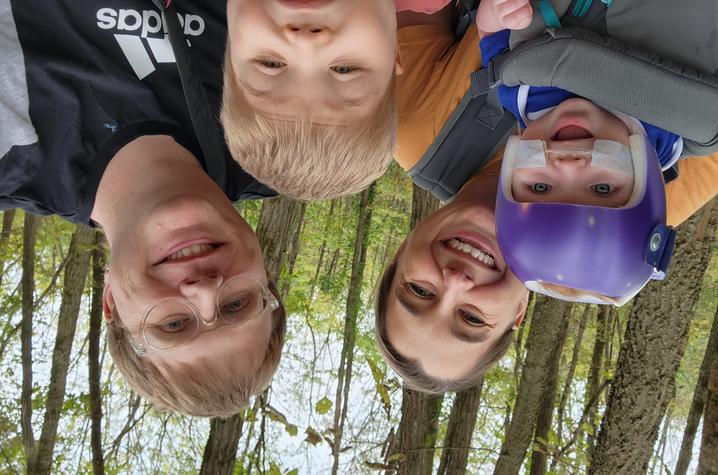From NICU to normalcy – one family’s story of extraordinary resilience
LEXINGTON, Ky. (Aug. 27, 2024) — Looking back at their sons’ health care journey over the past five years, Claire and Daniel Polston can’t help but note the extraordinary coincidences. Their first son, Everett, had a harrowing start to life when he was born at 23 weeks. Their second son, Nolan, had a nearly identical journey just a few years later.
“Nolan was admitted to the same hallway in the NICU as Everett,” said Claire. “They had many of the same nurses.” Claire and Daniel also felt the same trepidation and uncertainty that comes with having a baby admitted to a neonatal intensive care unit (NICU).
Everett Polston made a sudden and dramatic entrance into the world four months ahead of schedule. He spent the first 400 days of his life in the hospital being treated for complications associated with a premature birth, followed by a complex and dizzying care routine at home. He keeps his parents Claire and Daniel on their toes; his journey has been incredible — for any subsequent siblings, it would be a tough act to follow.
Just 23 weeks into her first pregnancy, Claire went into labor. She had to abandon her delivery plan and was transported to UK HealthCare to be in proximity to the Kentucky Children’s Hospital’s NICU. While the high-risk obstetrics team did what they could to slow Claire’s labor, Everett had other plans. He arrived 17 minutes after her water broke.
Because he was born so early, he had a number of conditions that required immediate and intensive intervention. After procedures to repair both the holes in his intestines and his heart, he was treated for severe pulmonary hypertension. A tracheostomy tube was placed to not only help his breathing, but also allowed him to be more alert, more mobile and grow and play the way a toddler should. Two years later, Everett had his trach tube removed and has since grown into a happy, active 5-year-old.
When he was three years old and his home care routine less complex and easier to manage, Claire and Daniel started thinking about a sibling for Everett.
“We knew that we wanted to have another child after Everett,” Claire said. “We were trying to see when we could get a bit more of an idea about Everett’s prognosis and wait hopefully for his medical challenges to calm down. We didn't want to add too many variables; we didn’t want it to be unfair for him because he needed so much attention. But we also didn’t want it to be unfair for this hypothetical other child as well.”
Even before she got pregnant, Claire was referred to a high-risk obstetrician. With Everett, she experienced a placental abruption, in which the placenta separates from the inner wall of the uterus before birth and deprives the baby of oxygen and nutrients. Placental abruptions almost always result in early delivery. Claire underwent a plethora of testing and genetic screenings, while her care team did what they could to ensure she had a full-term pregnancy and uneventful delivery.
‘It’s going to be different.’
Everything looked good until week 28.
“I had told myself, if anything feels off, we’re going to the doctor,” Claire said. She had dismissed her symptoms with Everett and put off going to the hospital when she was, in fact, in labor. “I just started feeling a little iffy and almost to the point where I was even blowing it off.”
Erring on the side of caution and colored by her experience with Everett, Claire and Daniel went to the hospital.
At 28 weeks, she was in labor. It was happening again.
Later, her obstetrics team would theorize that Claire’s body couldn’t carry a full-term pregnancy, leading to spontaneous preterm labor. But the more pressing issue was that of little Nolan, born Nov. 14, 2022, three months ahead of his due date.
“When they told me I was four centimeters, I lost it,” Claire said. “But the nurse said, ‘You're 28 weeks, it's going to be different.’ And it has been different.”
The difference between Everett’s 23-week gestation and Nolan’s 28-week gestation doesn’t seem like much, but in terms of in utero development, it can be the difference between life and death. Babies born at 23 weeks have a much lower survival rate than those born five weeks later — 60% versus 80-90%. But just because Nolan was further along than Everett when he was born doesn’t mean his journey was smoother.
Every baby is born with a patent ductus arteriosus (PDA), a normal fetal artery that connects the aorta and the pulmonary artery, allowing blood to detour away from the lungs before birth. After birth, the opening is no longer needed and usually narrows and closes within the first few days. Failure of the ductus to close is common in premature infants. Just like his big brother, Nolan’s ductus was still open after birth. But unlike Everett, Nolan also had a hole in the wall between the top two chambers of his heart, called an atrial septum defect (ASD). After 30 days in the NICU at Baptist Health, Nolan was transported down the street to the NICU at Kentucky Children’s Hospital (KCH).
‘Maybe you’ll see us soon.’
A few weeks after Nolan was born, Claire and Everett stopped by KCH, dropping off toys for the holiday toy drive and visiting with the nurses and staff they had gotten to know so well during Everett’s 400-day stay.
“I was updating them on Nolan, joking with them and saying, ‘Maybe you’ll see us soon,’” Claire said. “Nolan was transferred that afternoon.”
Even though the fear and uncertainty were still there, Claire and Daniel felt more prepared for this second NICU stay. Those coincidences they noted — the same hallway, the same nursing staff — brought a small amount of comfort. They were in a familiar place, surrounded by friends.
“One of Everett’s primary nurses actually admitted Nolan,” said Claire. “We were so excited to have familiar faces. I remember driving home that night after Nolan had been transferred; we knew the nurse that had him that night and we felt good about it. We knew he was loved. It was a level of comfort that we felt going back to what had become our second home.”
While Everett’s medical issues stemmed from his lungs, underdeveloped because of his premature birth, Nolan’s concern was his heart. The two openings, the PDA and the ASD, are not uncommon congenital heart defects and can be treated with a combination of medication and surgery. But during the surgery, his care team found a bigger problem.
Pulmonary vein stenosis (PVS) is a rare and serious condition in which blood vessels deliver oxygenated blood from the lungs back into the heart are narrowed or blocked. Without it, the heart can’t deliver oxygen to the rest of the body, leading to detrimental and irreversible damage to tissues and organs.
“From what we gathered, there aren’t a lot of adults who had pulmonary vein stenosis as kids because the survival rate was so horrible,” said Claire. Children born with PVS 30 years ago were unlikely to survive. While pediatric pulmonary vein stenosis has been studied for many years, only in the last 20 years have researchers and physicians had success with implementing pharmacologic and interventional strategies to treat the disease.
As much as they loved KCH, the Polstons started looking at other hospitals for treatment options for Nolan. His condition was so rare — where would they have to go for advanced treatment, research and providers with specialized experience?
They wouldn’t have to go anywhere at all. The Joint Pediatric and Congenital Heart Program is a collaboration with Cincinnati Children’s Hospital Medical Center, a one-program, two-site model that provides the full spectrum of cardiac care and exceptional heart treatment for Kentucky families close to home. The program is one of the top pediatric cardiology programs in the country, according to U.S. News and World Report.
Nolan’s cardiologist, Michelle C. Sykes, M.D., has trained with and continues to consult with the leading institutions pioneering therapies for pulmonary vein stenosis.
“Pulmonary vein stenosis occurs when the blood vessels returning blood from the lungs to the heart become thickened, blocking the flow of blood and leading to congestion in the lungs and quite often increased pressure in the lungs, a condition called pulmonary hypertension,” said Sykes. “We have many ways of addressing pulmonary vein stenosis, including surgery, cardiac catheter-based interventions and some medications. Not every patient will respond to just one of these treatments, and often we will use them in combination.”
PVS is an aggressive disease and despite the progress in understanding it and implementing more treatment interventions, it still has a high morbidity and mortality rate — only 60% survival in the first five years of life.
“However, for Nolan in particular, he’s come such a long way and he’s done so well clinically that I’m hopeful he will continue to surpass our expectations,” said Sykes. “I’ve had the privilege of seeing him grow into a healthy and active young boy, much like his brother. He requires close monitoring and continued treatment, and his entire care team — with his parents being front and center of that team — are critical to his ongoing health and progress.”
Family of four
Between Baptist Health and KCH, Nolan spent 130 days in the NICU. Between supporting Nolan while he was in the hospital and making sure Everett got the attention he needed, Claire and Daniel credit not just the NICU staff for their help, but a vast network of family and friends who helped them find the balance. Grandparents helped chauffeur Everett between school and therapy while Daniel worked, and Claire was with Nolan. On weekends, they wanted Everett to partake in typical fun activities and relied on KCH staff to make sure Nolan had plenty of love and attention.
“When Everett was our only kid, we were at the NICU all the time,” said Claire. “Figuring out how to do this as a family of four instead of three was more difficult. But it was incredibly reassuring knowing that Nolan was cared for when we couldn’t be there because we wanted to make sure Everett got typical experiences that we had been dreaming of during his trach days.”
In January 2023, Everett came to KCH for a routine tonsillectomy. While Daniel stayed with Everett on the fourth floor of the hospital, Claire was with Nolan in the NICU on the first floor. It was the first night they spent together as a family of four under one roof.
To date, Nolan has undergone eight heart catheterization procedures to insert stents into his blood vessels to hold them open. He was discharged from the NICU on March 24, 2024, only to be readmitted to KCH eight more times between April and June. Once Nolan was home for good, Everett enthusiastically stepped into the role of loving big brother.
“They just adore each other,” said Claire. “Everett loves to make Nolan laugh, which sometimes means he’s doing something he’s not supposed to be doing. But then Nolan starts to laugh and egg him on. He thinks Everett is the funniest guy in the world.”
Both Everett and Nolan have ongoing support for their respective conditions. Because Everett had a tracheostomy tube and Nolan’s condition leads to a feeding intolerance, neither had eaten by mouth for prolonged periods. They both have gastronomy tubes, and conveniently, see the same feeding therapist. Everett and Nolan have both made excellent progress; normal family outings, which for so long seemed like an impossibility, are quickly becoming an attainable reality.
Loading up their SUV with typical infant and toddler gear, such as stroller wagon, pack and play and diapers, they also had to make room for Everett and Nolan’s oxygen tanks, g-tube supplies and food as well as every conceivable essential for two children under the age of five with complex medical issues, the Polstons set off for their first family trip to the Cincinnati Zoo and to see the solar eclipse. Not only did they have a blast, but it also opened a world of possibilities for future family adventures, one day unencumbered by medical gear.
The bond of brotherhood
Both Everett and Nolan will require specialized care for the rest their lives: follow-up with a pulmonologist for Everett and routine heart cath procedures for Nolan. In a way, Claire says, they share a bond beyond brotherhood.
“And this is something that they can always bond over, and take care of each other, and make sure that the other is following up with what they need to do,” said Claire. With the countless physicians, surgeons, nurses, social workers, therapists, techs, child life specialists and administrators who were involved in their care, as well as the Polston’s network of family and friends, Everett and Nolan have an army of role models in empathy, compassionate care and unconditional love.
“It’s been a wild five years,” Claire said. “We have incredible family support and incredible friends. While we were in the hospital, we were treated like friends by staff. Without that support, we’d be in a much different place. We feel very fortunate that we’ve had the people around us that we’ve had to help us. And I think that we would be in a much different spot without that. These boys make us laugh every single day. We just feel very fortunate to call them ours.”
UK HealthCare is the hospitals and clinics of the University of Kentucky. But it is so much more. It is more than 10,000 dedicated health care professionals committed to providing advanced subspecialty care for the most critically injured and ill patients from the Commonwealth and beyond. It also is the home of the state’s only National Cancer Institute (NCI)-designated Comprehensive Cancer Center, a Level IV Neonatal Intensive Care Unit that cares for the tiniest and sickest newborns and the region’s only Level 1 trauma center.
As an academic research institution, we are continuously pursuing the next generation of cures, treatments, protocols and policies. Our discoveries have the potential to change what’s medically possible within our lifetimes. Our educators and thought leaders are transforming the health care landscape as our six health professions colleges teach the next generation of doctors, nurses, pharmacists and other health care professionals, spreading the highest standards of care. UK HealthCare is the power of advanced medicine committed to creating a healthier Kentucky, now and for generations to come.









